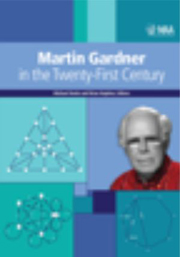Book contents
- Frontmatter
- Preface
- Contents
- I Geometry
- 1 The Asymmetric Propeller
- 2 The Asymmetric Propeller Revisited
- 3 Bracing Regular Polygons As We Race into the Future
- 4 A Platonic Sextet for Strings
- 5 Prince Rupert's Rectangles
- II Number Theory and Graph Theory
- III Flexagons and Catalan Numbers
- IV Making Things Fit
- V Further Puzzles and Games
- VI Cards and Probability
- VII Other Aspects of Martin Gardner
- Index
- About the Editors
3 - Bracing Regular Polygons As We Race into the Future
from I - Geometry
- Frontmatter
- Preface
- Contents
- I Geometry
- 1 The Asymmetric Propeller
- 2 The Asymmetric Propeller Revisited
- 3 Bracing Regular Polygons As We Race into the Future
- 4 A Platonic Sextet for Strings
- 5 Prince Rupert's Rectangles
- II Number Theory and Graph Theory
- III Flexagons and Catalan Numbers
- IV Making Things Fit
- V Further Puzzles and Games
- VI Cards and Probability
- VII Other Aspects of Martin Gardner
- Index
- About the Editors
Summary
If today's math-and-science-oriented kids could see the resources available to like-minded youths of the 1960s and 70s, they might pity their counterparts back then: no laptop computers, no high-speed internet, no online bookstores. Yet such pity would be wasted on that earlier generation, who could well respond, “Ah, but we had Martin Gardner.”
For a quarter century, Gardner wrote Mathematical Games, a wonderful column in Scientific American [3]. Each month he treated his readers to a tour of some mathematical recreation that he made tantalizing for people who, like himself, had no advanced training in mathematics. He was at the center of an amazing human network, referred to as “Martin Gardner's mathematical grapevine” by Doris Schattschneider [7].
Long before our current electronic networks, Gardner gathered juicy mathematical tidbits from his far-flung contacts, turned them into mouth-watering morsels, and encouraged readers to send back their own variations. How many thousands leaped into mathematical, scientific, and engineering fields because of the enthusiasm nurtured by this singular man? Let's reach back in time to sample a problem that Gardner introduced and explore the magic that he created, magic which would expand as we raced towards our technological future.
Bracing a square
In his November 1963 column, Gardner dished up a tasty problem devised by Raphael Robinson, a mathematician at the University of California, Berkeley, who is best known for determining the minimum number of pieces for the Banach-Tarski paradox.
- Type
- Chapter
- Information
- Martin Gardner in the Twenty-First Century , pp. 11 - 18Publisher: Mathematical Association of AmericaPrint publication year: 2012

